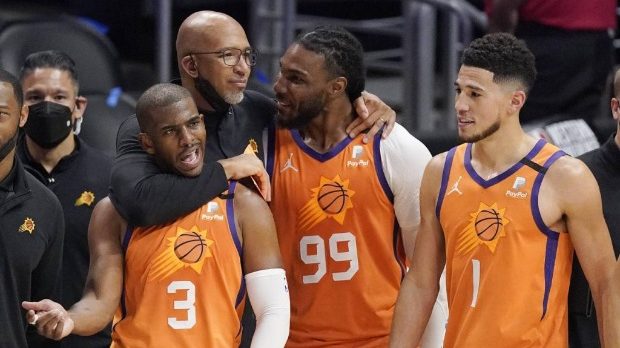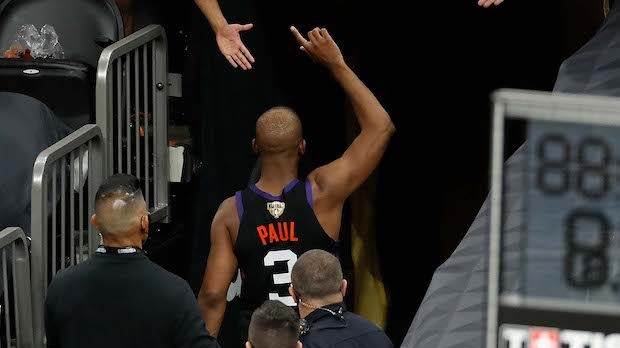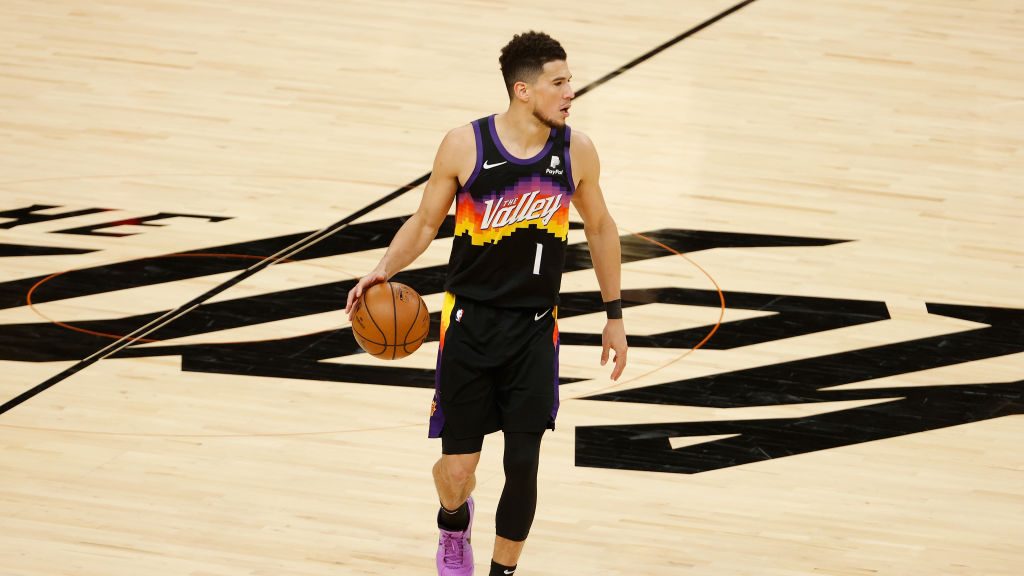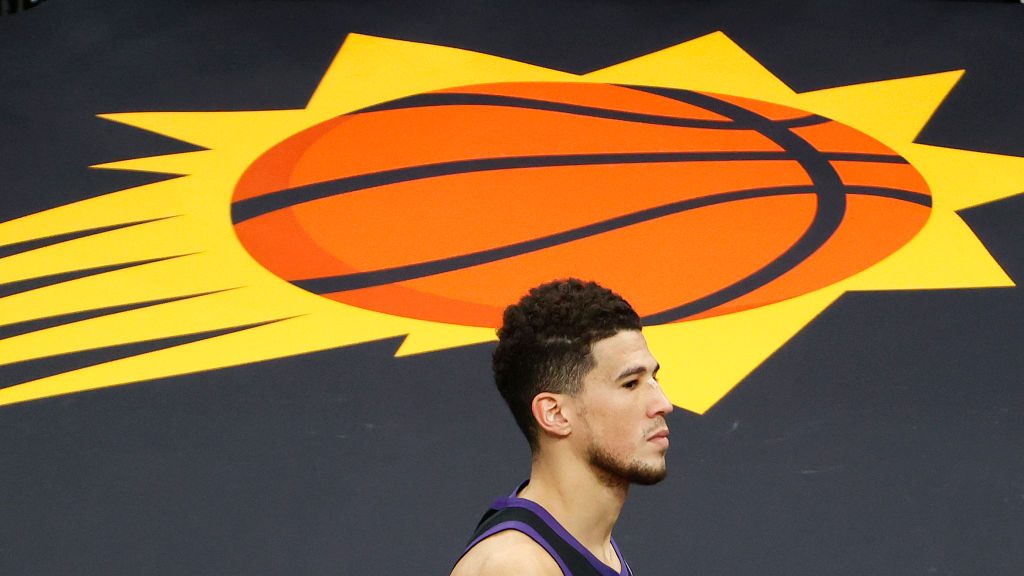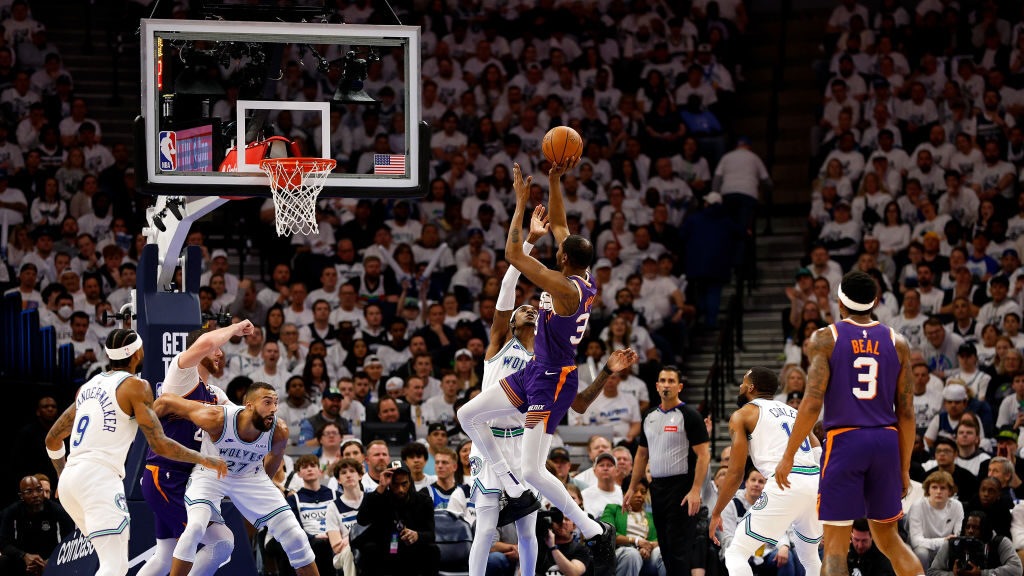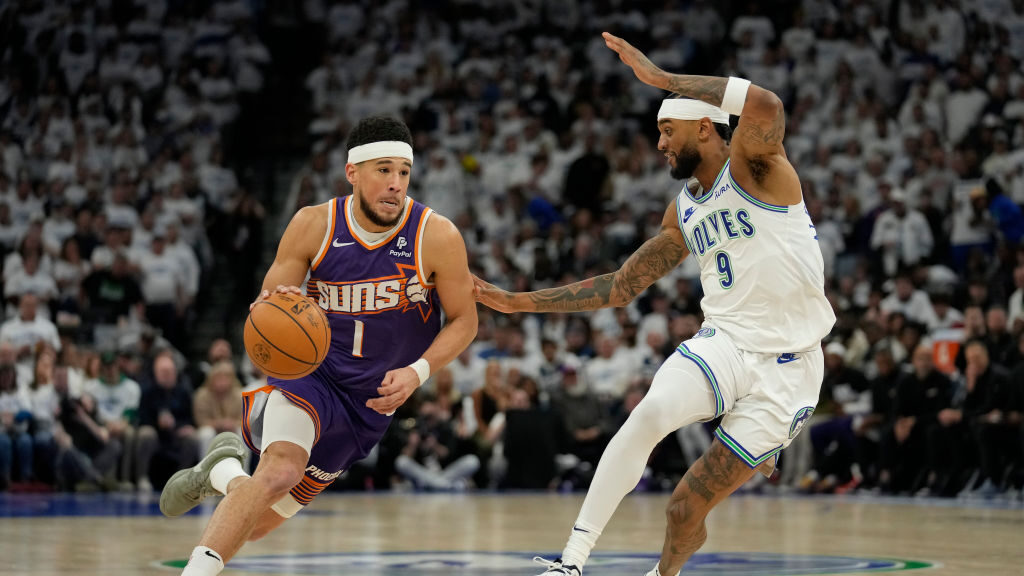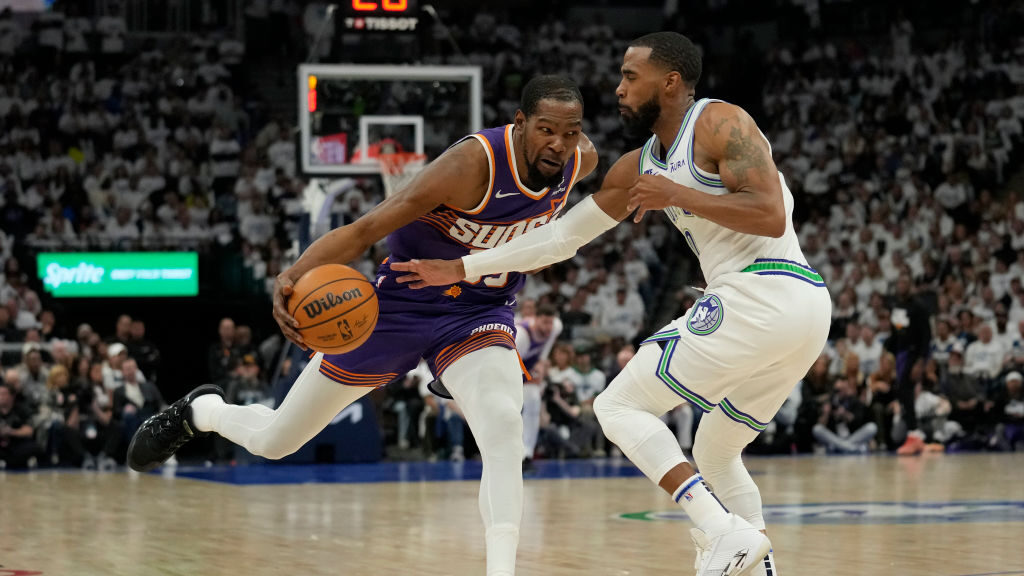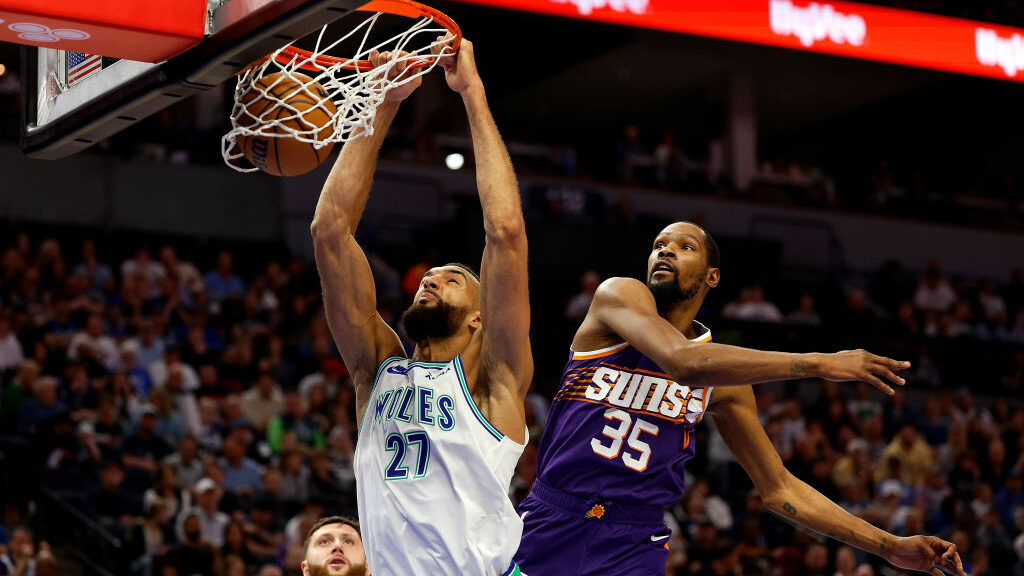3-and-D to 3-level scorer: The case for Mikal Bridges’ scoring upside
Oct 4, 2021, 1:39 PM | Updated: 8:41 pm

Mikal Bridges #25 of the Phoenix Suns reacts to three-point shot against the Utah Jazz during the first half of the NBA game at Phoenix Suns Arena on April 30, 2021 in Phoenix, Arizona. (Photo by Christian Petersen/Getty Images)
(Photo by Christian Petersen/Getty Images)
PHOENIX — Labels can be a bit tiring. It feels like we’re getting there with “3-and-D.”
What shooting percentage is good enough to earn the 3? How about the clamps for D? Does everyone qualify? Technically, Kevin Durant is the best 3-and-D player, right?
There’s a premium on the skill set, especially for supporting cast members who play off an All-Star or two, thus the use of the label and why it will continue.
One thing is for sure, though, that most players are not a fan of it. And with good reason. It puts them in a box.
Whenever it’s been mentioned to Phoenix Suns shooting guard Devin Booker in regards to his teammate Mikal Bridges, he has been quick to emphasize that Bridges shouldn’t be restricted to that.
But if you were paying attention enough last season, while Bridges certainly earned that 3 while bumping his three-point percentage from 36.1% to 42.5%, he was also implementing improvements to his offensive game. He did so with relatively unheard-of efficiency, shifting his statistical profile to less of a 3-and-D player and more of a 3-level scorer.
We’ll start here: the 25-year-old Bridges took less than 10 shots a game last year. We’re gonna be doing a little bit of some good ol’ projecting and forecasting ahead on this journey, so if you aren’t comfortable with it off that sample size, we’re going to stop the ride and allow you to get off it if you’re not.
Go ahead! No one is judging you! We’ll all look away so we don’t make it weird. Sorry. We will count to 10. Ready, go.
…
…
Ah, you’re still here! Splendid! Let’s dive in.
Bridges’ shooting profile on Cleaning the Glass is borderline art.
His attempts from the midrange jumped this past season from 86 to 145, a slight uptick to 22% of his total shots. But the most important part by far is the percentage of those he made shot up from 36% to 50%, one of the best marks you’ll see across the league.
Bridges got cozy taking a dribble or two to get to his spots between 8-18 feet, where his affinity for smooth touch really shined. At times, this even expanded to a handful of bounces with a ball screen and some hesitation moves sprinkled in.
At the rim, Bridges improved on an already-spectacular 73% efficiency last season to 76%.
Again, the dude just has an innate feel for putting the ball in the basket in certain spots. He contorts his body to position himself better at times, where he’s become one of the best transition finishers in the league. Those long arms and superb cutting feel don’t hurt, either.
From deep, Bridges’ 3-point number we mentioned earlier was greatly aided by a 40% conversion rate on 3s not from the corners. Again, that’s one of the better numbers you’ll see, and again, he has an ease to shooting where he looks like a natural. The sniper we saw at Villanova is fully back, and he’s doing it off movement and the dribble now too.
That “What?!” you hear at the end of the last clip is from TNT’s Reggie Miller, one of the greatest shooters ever, providing an audible response to Bridges on the move turning and firing in one fluid motion. He knows how tough that shot is.
If you want to make sure you’re reading this right, yes, you are correct in thinking this means that Bridges has terrific shooting percentages in all three areas of the floor. Hence, that 3-level scorer point earlier.
Add all this up together and it was one of the most efficient shooting seasons in league history.
Focusing on Bridges’ 9.3 field goal attempts per game, looking at players to average at least nine shots and two 3s a game, Bridges posted the third-best season ever in terms of true shooting percentage, per Basketball-Reference. True shooting percentage gives us a better idea than field goal percentage of efficiency by incorporating 3P% and FT%, the latter of which Bridges was at 84.0%, by the way.
Bridges’ TS% clocked in at 66.7%, trailing only Miami’s Duncan Robinson in 2019-20 (68.4%) and Stephen Curry’s 2015-16 MVP season with Golden State (66.9%).
Bridges’ volume has long faded away from being a 3-and-D player. He took 44% of his shots at range, a slightly below-average mark for wings last year, per Cleaning the Glass.
So are there any other indicators here of something much bigger on the horizon? Let’s compare those numbers with a few of his peers, focusing on wings who were late bloomers that didn’t explode on the scene right away.
With Bridges entering his fourth year, here’s where his shooting profile compares to those players’ percentage of shots he’s taking at the rim, midrange and on 3s, followed by the FGAs per game and TS%.
Year 3 Mikal Bridges: 34%/22%/44%, 9.3 FGA/G, 66.7 TS%
Year 3 Kawhi Leonard: 37%/37%/27%, 9.8 FGA/G, 60.2 TS%
Year 2 Paul George: 38%/29%/34%, 9.7 FGA/G, 55.5 TS%
Year 3 Jimmy Butler: 41%/30%/29%, 10.3 FGA/G, 52.2 TS%
Year 3 Khris Middleton: 21%/50%/29%, 11.0 FGA/G, 56.3 TS%
Year 2 Danny Granger: 26%/41%/33%, 10.6 FGA/G, 57.3 TS%
Hmm. OK. Our No. 1 takeaway is that Bridges’ midrange number is lower, with Bridges’ being weighed down by the amount of trey balls he hoisted. No one else except George and Granger even reach 30% for their 3s, but still not even close to Bridges’ 44%.
We can roll with that because, once more, Bridges’ role dictated him as a 3-and-D guy to space the floor on an excellent team with two dominant ball-handlers.
Let’s look at the efficiency from those three areas to expand on the true shooting percentages.
Year 3 Mikal Bridges: 76%/50%/43%
Year 3 Kawhi Leonard: 69%/49%/37%
Year 2 Paul George: 61%/32%/38%
Year 3 Jimmy Butler: 57%/34%/30%
Year 3 Khris Middleton: 59%/46%/41%
Year 2 Danny Granger: 65%/39%/39%
Well, all of that certainly jumps off the page, eh? We’ve got Bridges with the highest entries in all three facets. He’s also benefitting from the best scenario among all those guys in his role, drawing less attention and an easier matchup, so let’s not get too carried away.
Is this my grand argument to say Bridges is about to join that echelon of scorers? It is not. But it is a point to say that the signs of him getting there are 1) present and 2) encouraging, and that Bridges has plenty of upside left to his game as he has a few years left still before getting to his prime.
Here’s Suns head coach Monty Williams after practice on Sunday in regards to Bridges’ offensive improvement the last two seasons:
“The work ethic allows for him to continue to grow,” he said. “Just a tireless worker. He’s one of the guys you have to kick out of the gym … He just works his tail off.”
When Chris Paul was asked who jumped out to him at the start of camp among the younger players, he immediately said Bridges.
Bridges outlined that he spent the offseason working on his shot even more, as well as tightening up his handle a bit.
Back during the NBA Finals, Bridges said that in his first season at Villanova when his perimeter jumper wasn’t falling as a reserve, he had to figure out other ways to score to stay on the floor for a national champion. By the end of his junior year, he had developed that repertoire.
But he also had to have a change in his mindset at the pro level. Bridges started telling himself during games that he needed to hit a 3 to get himself going after not touching the ball for a while, but during the Western Conference Finals, veteran guard E’Twaun Moore told Bridges to mix it up and try to get to the rim.
“And I’m like, ‘Damn, that’s what I was doing and I just forgot. I was just trying to hit a 3,'” Bridges said in July.
It’s worth mentioning that as a reminder of Bridges’ experience level in the league and his part on the team. It’s almost as if the growth Bridges went through offensively at Villanova had to start over and occur again with the Suns.
The conclusion here is less about Bridges being an All-Star in 2-3 years and more about him becoming a consistent offensive threat in Phoenix’s system. He’s capable of being that this season, but he’s still gotta get there. This past year, Bridges scored in single digits for 21 of his 72 games. When he reached 18 points, the Suns went 18-3, also a 21-game total. Finding a balance there would make a huge difference.
To go back to where we kicked off on this whole labels thing, tagging Bridges as a “3-level scorer” quickly has your brain taking you to someone averaging 25 a night and making All-NBA teams, right?
Let’s not go there. At least, not yet. For now, it’s about Bridges being far more offensively than a shooter in the corner and outstanding cutter.
“Since we’ve gotten here, I knew what he could do from a cutting and moving without the ball but now he’s gotten so used to playing with the ball and we need him to,” Williams said. “We want to put him in environments that allow for him to be a third option for us on any given night and I think he’s capable of it.”
Those clips above are all from the highest levels of basketball, mostly the NBA Finals, where Bridges was utilizing those parts of his game with that extra freedom Williams gave him.
The playoff run can be a huge stepping stone for Phoenix’s young core, and if there’s one thing we’ve learned about Bridges through three years in Phoenix, it’s that the guy works. A hitch developed in his jumper for his first two seasons, one he battled through, all while his playing time began to slightly fade at the beginning of the 2019-20 season.
That’s a wall a lot of young players smack into and fail to get back up from, but Bridges kept running into it until he bursted through to the player he’s become now and will in the future.
“His focus is there every single moment,” Booker said in July. “You get to the gym, Mikal is there. He’s putting in extra work, he’s there after. People will still try to label him as the 3-and-D guy and I’ve told you guys multiple times that’s not even close to his game … He gets it going. If teams wanna try and make him be the one to beat him, he’ll do it.”


